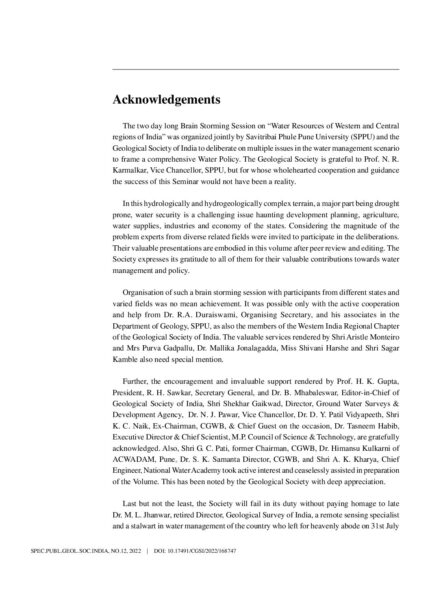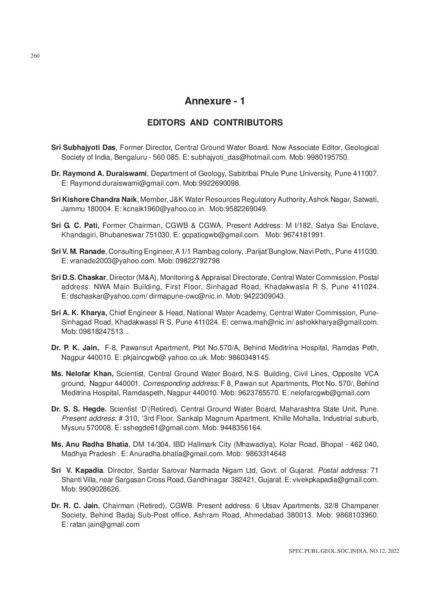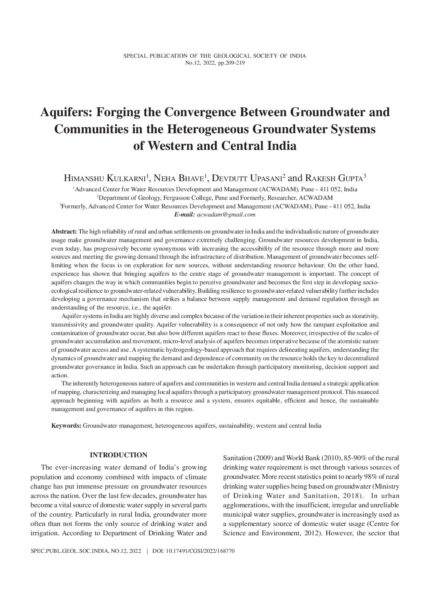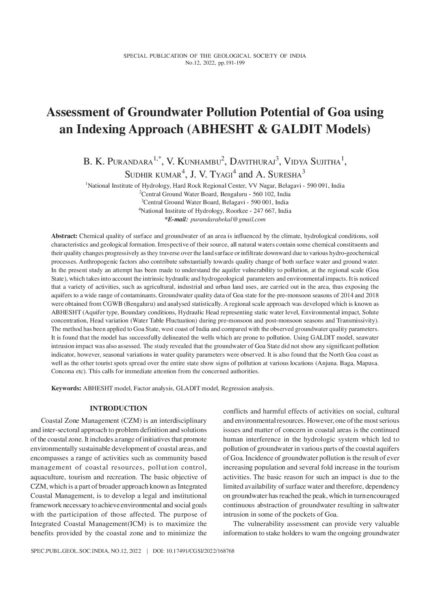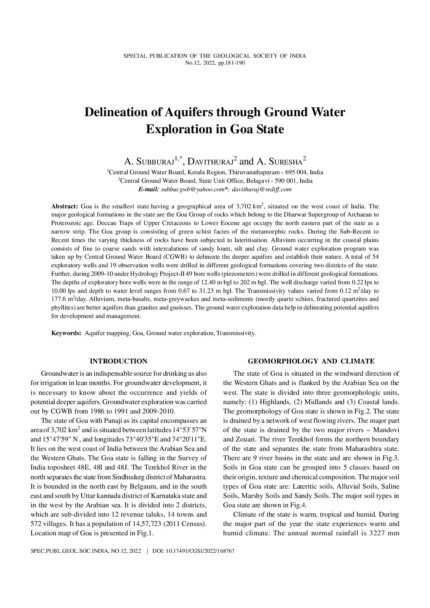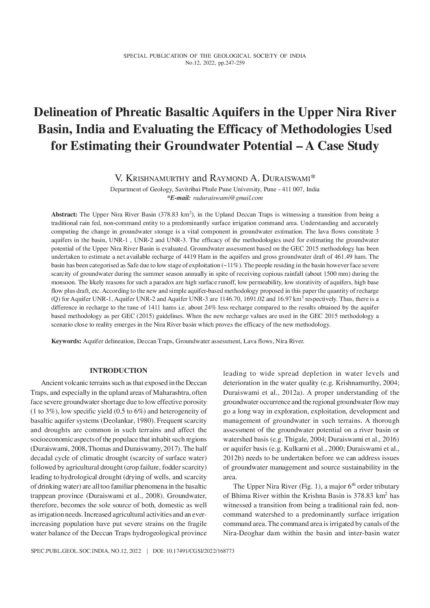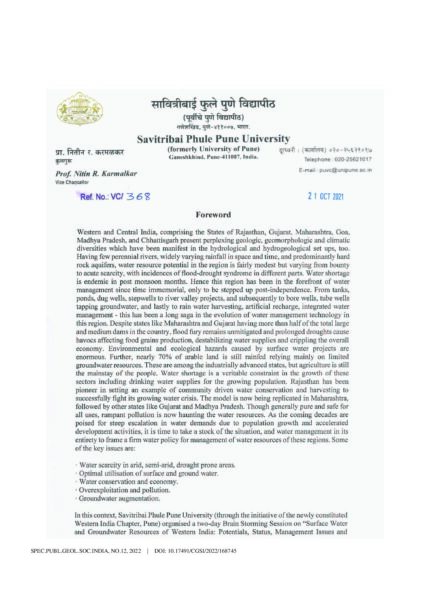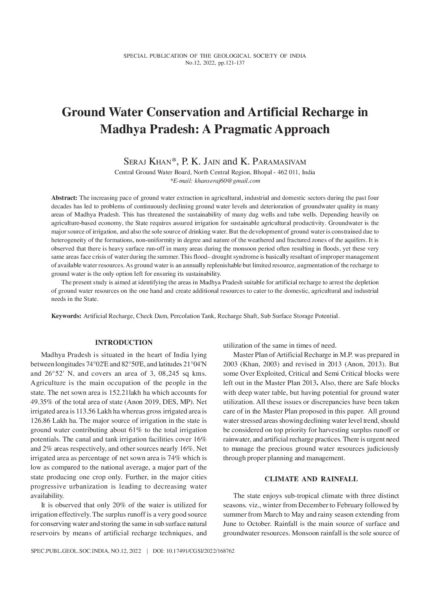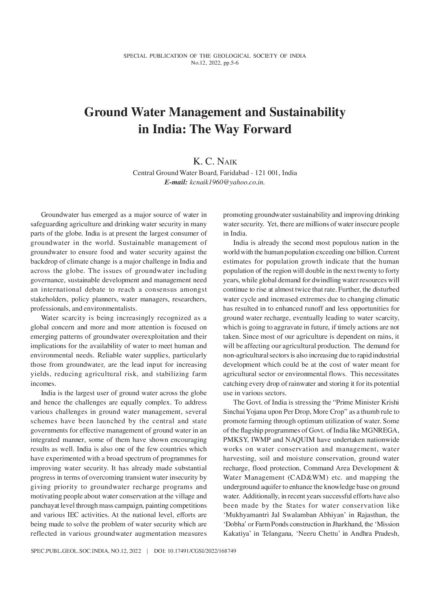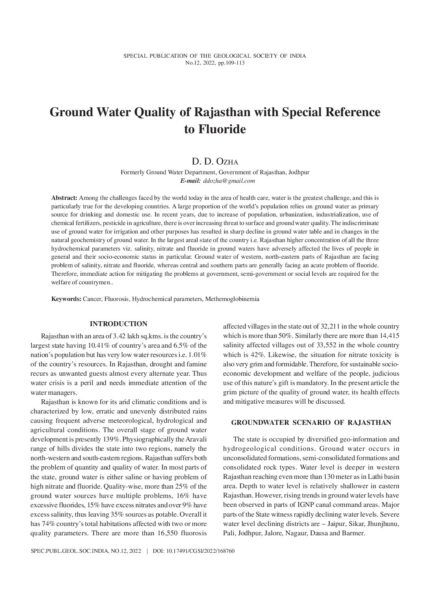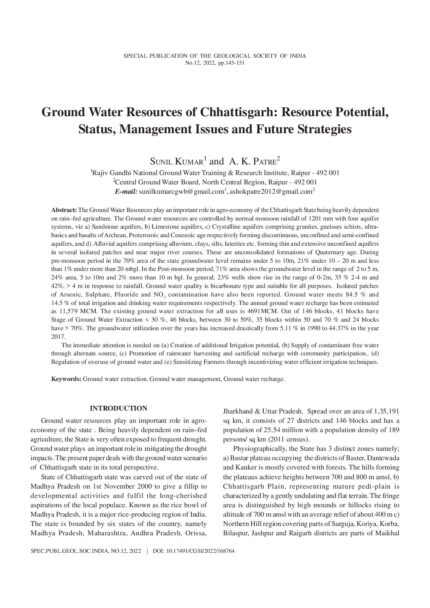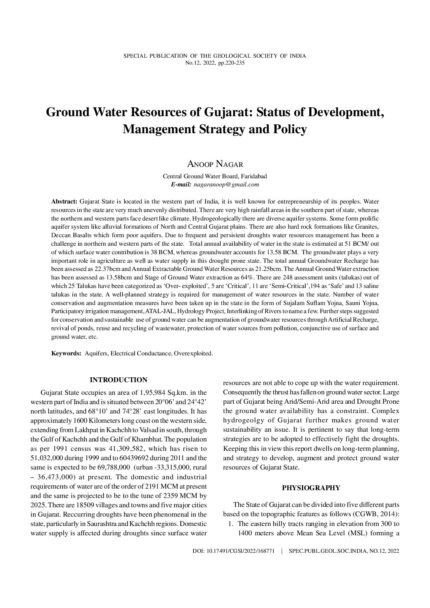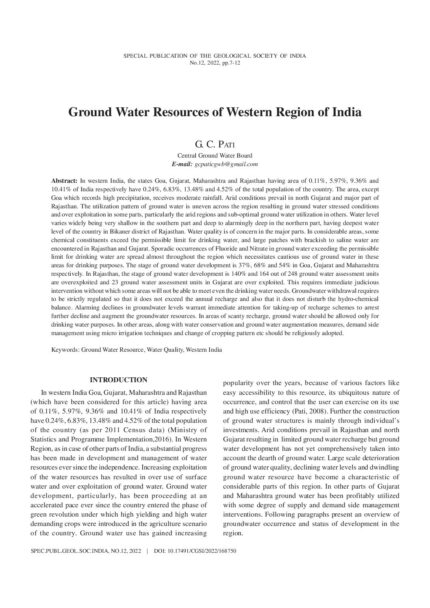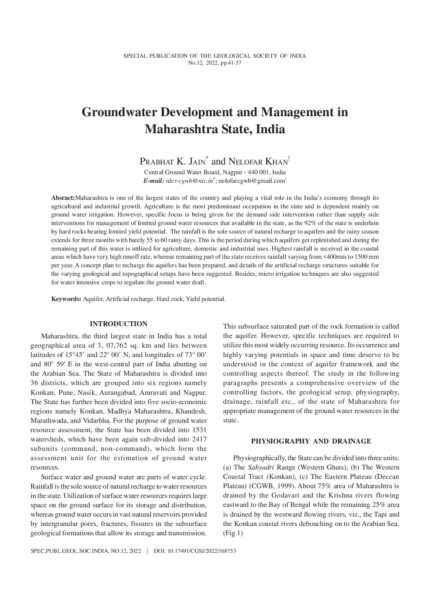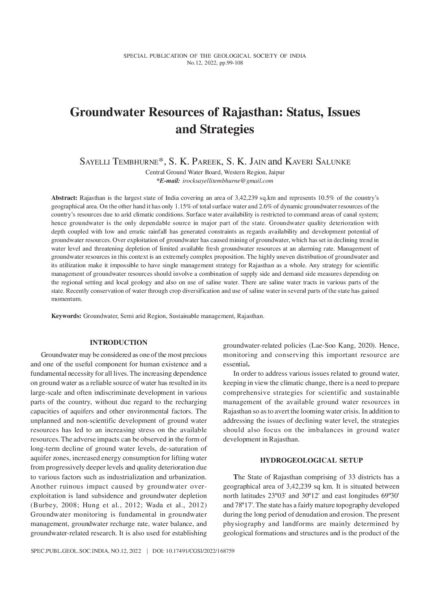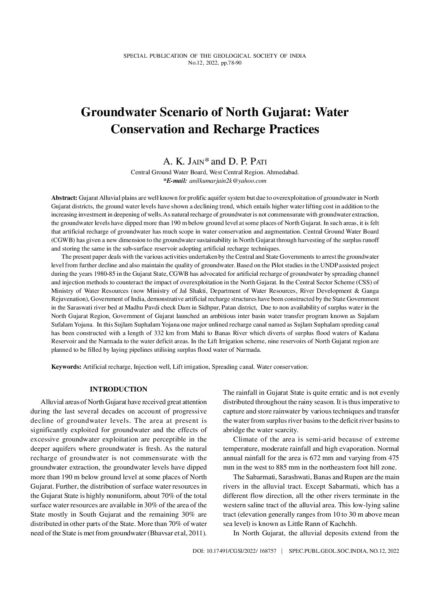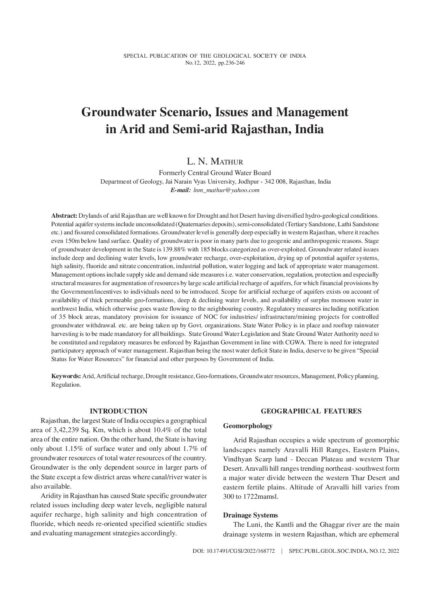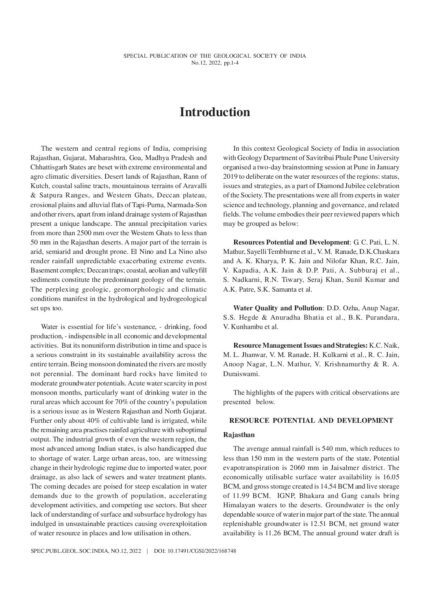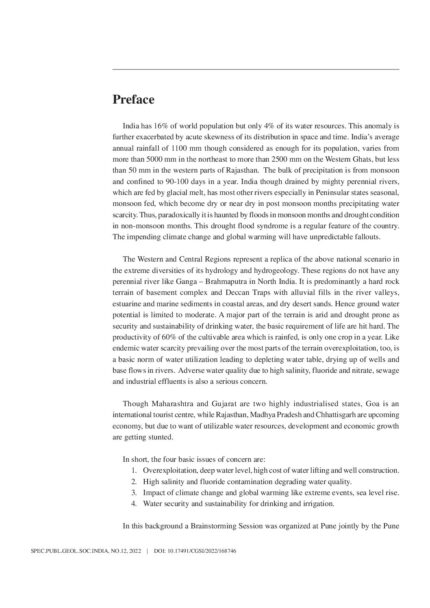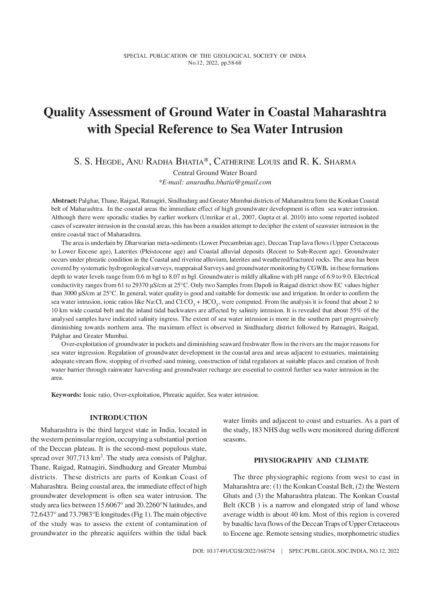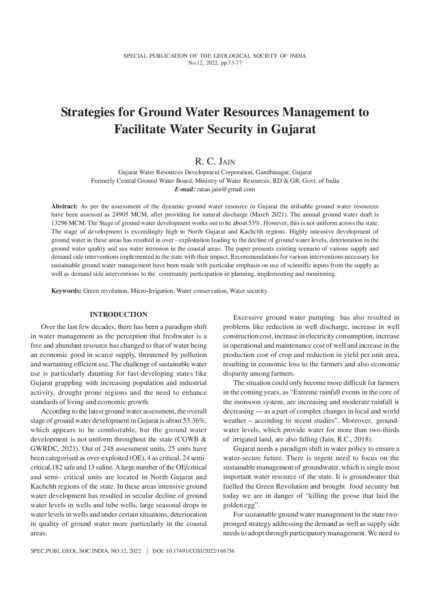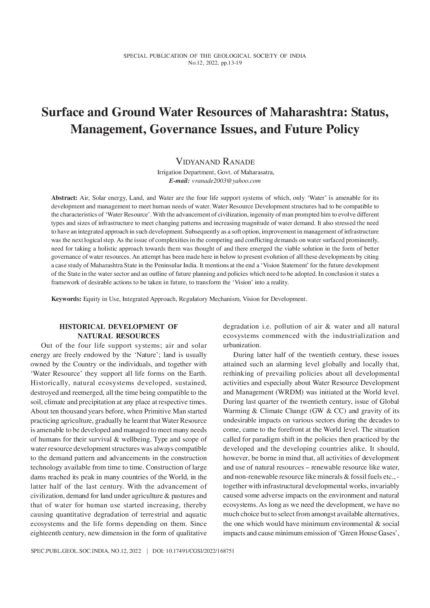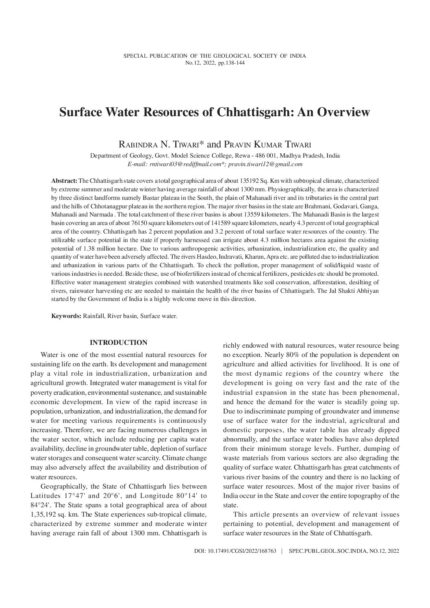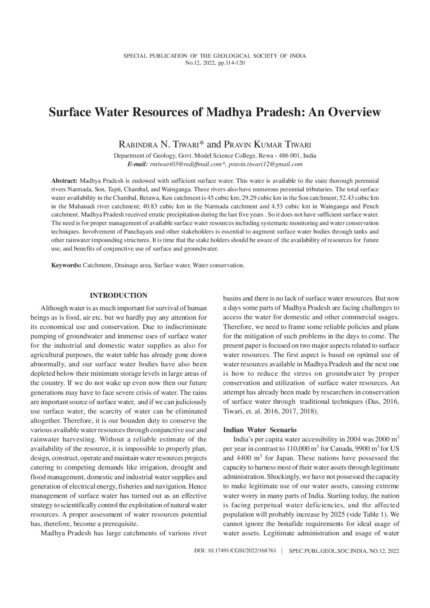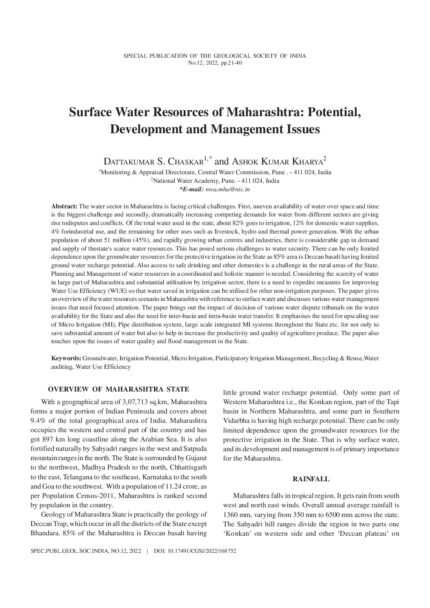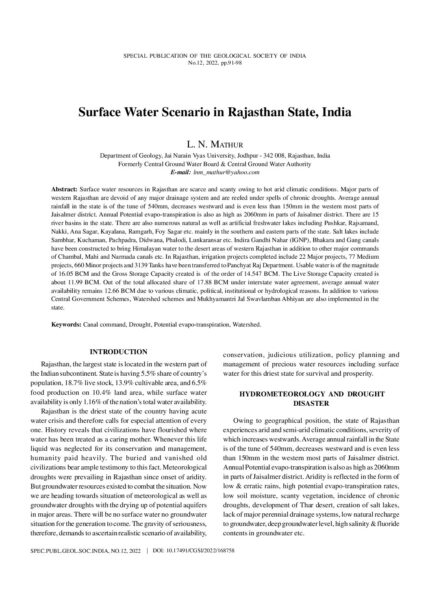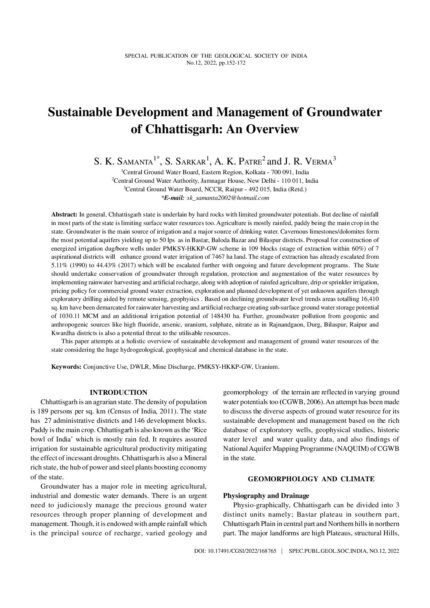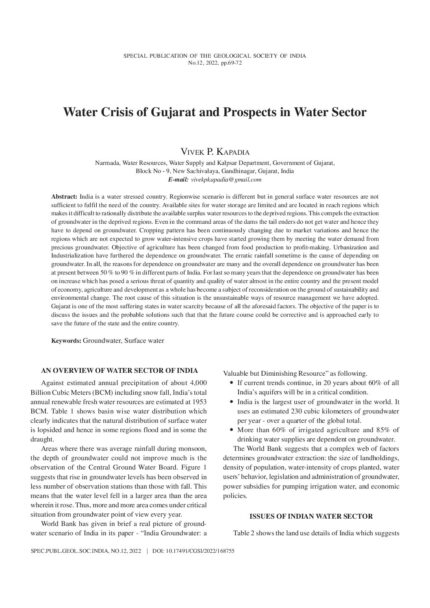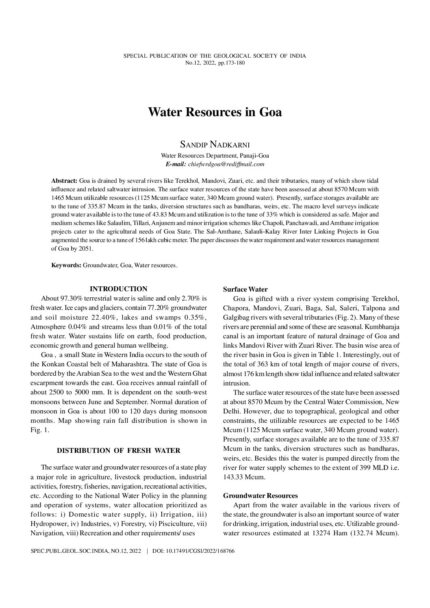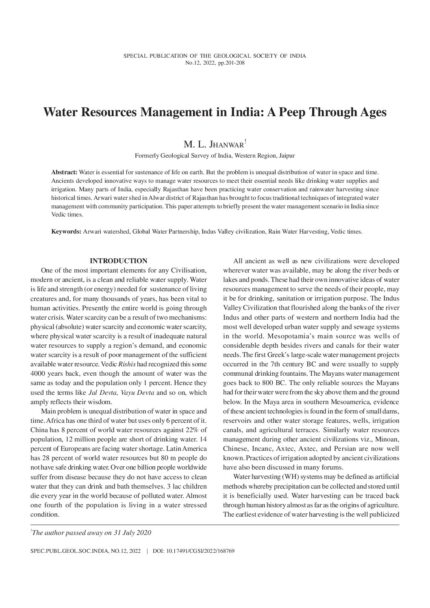SP-12: Water Resources of Western and Central Regions of India: Status, Issues and Strategies
Aquifers: Forging the Convergence Between Groundwater and Communities in the Heterogeneous Groundwater Systems of Western and Central India
Conference Papers, SP-12: Water Resources of Western and Central Regions of India: Status, Issues and Strategies
SKU:
C-168770
The high reliability of rural and urban settlements on groundwater in India and the individualistic nature of groundwater usage make groundwater management and governance extremely challenging. Groundwater resources development in India, even today, has progressively become synonymous with increasing the accessibility of the resource through more and more sources and meeting the growing demand through the infrastructure of distribution. Management of groundwater becomes selflimiting when the focus is on exploration for new sources, without understanding resource behaviour. On the other hand, experience has shown that bringing aquifers to the centre stage of groundwater management is important. The concept of aquifers changes the way in which communities begin to perceive groundwater and becomes the first step in developing socioecological resilience to groundwater-related vulnerability. Building resilience to groundwater-related vulnerability further includes developing a governance mechanism that strikes a balance between supply management and demand regulation through an understanding of the resource, i.e., the aquifer.Aquifer systems in India are highly diverse and complex because of the variation in their inherent properties such as storativity, transmissivity and groundwater quality. Aquifer vulnerability is a consequence of not only how the rampant exploitation and contamination of groundwater occur, but also how different aquifers react to these fluxes. Moreover, irrespective of the scales of groundwater accumulation and movement, micro-level analysis of aquifers becomes imperative because of the atomistic nature of groundwater access and use. A systematic hydrogeology-based approach that requires delineating aquifers, understanding the dynamics of groundwater and mapping the demand and dependence of community on the resource holds the key to decentralized groundwater governance in India. Such an approach can be undertaken through participatory monitoring, decision support and action.The inherently heterogeneous nature of aquifers and communities in western and central India demand a strategic application of mapping, characterizing and managing local aquifers through a participatory groundwater management protocol. This nuanced approach beginning with aquifers as both a resource and a system, ensures equitable, efficient and hence, the sustainable management and governance of aquifers in this region.
Assessment of Groundwater Pollution Potential of Goa using an Indexing Approach (Abhesht & Galdit Models)
Conference Papers, SP-12: Water Resources of Western and Central Regions of India: Status, Issues and Strategies
SKU:
C-168768
Chemical quality of surface and groundwater of an area is influenced by the climate, hydrological conditions, soil characteristics and geological formation. Irrespective of their source, all natural waters contain some chemical constituents and their quality changes progressively as they traverse over the land surface or infiltrate downward due to various hydro-geochemical processes. Anthropogenic factors also contribute substantially towards quality change of both surface water and ground water. In the present study an attempt has been made to understand the aquifer vulnerability to pollution, at the regional scale (Goa State), which takes into account the intrinsic hydraulic and hydrogeological parameters and environmental impacts. It is noticed that a variety of activities, such as agricultural, industrial and urban land uses, are carried out in the area, thus exposing the aquifers to a wide range of contaminants. Groundwater quality data of Goa state for the pre-monsoon seasons of 2014 and 2018 were obtained from CGWB (Bengaluru) and analysed statistically. A regional scale approach was developed which is known as ABHESHT (Aquifer type, Boundary conditions, Hydraulic Head representing static water level, Environmental impact, Solute concentration, Head variation (Water Table Fluctuation) during pre-monsoon and post-monsoon seasons and Transmissivity). The method has been applied to Goa State, west coast of India and compared with the observed groundwater quality parameters. It is found that the model has successfully delineated the wells which are prone to pollution. Using GALDIT model, seawater intrusion impact was also assessed. The study revealed that the groundwater of Goa State did not show any significant pollution indicator, however, seasonal variations in water quality parameters were observed. It is also found that the North Goa coast as well as the other tourist spots spread over the entire state show signs of pollution at various locations (Anjuna. Baga, Mapusa. Concona etc). This calls for immediate attention from the concerned authorities.
Delineation of Aquifers through Ground Water Exploration in Goa State
Conference Papers, SP-12: Water Resources of Western and Central Regions of India: Status, Issues and Strategies
SKU:
C-168767
CGWB (1997) Master Plan for Goa state. Central Ground Water Board, Faridabad. CGWB (2009-2011) Basic Data reports of Piezometers. Hydrology Project-II in North and South Goa Districts, Goa State, Central Ground Water Board, 2011. CGWB (2013) Report on Ground Water Exploration in Goa State. Technical Report of Central Ground Water Board, Faridabad, 2013. CGWB (2015) State Report of Goa (Hydrochemistry), Central Ground Water Board, Faridabad, 2015. DPSE (2009) Statistical Handbook of Goa. Directorate of Planning, Statistics and Evaluation, Panaji, Goa, 2009. DOWR (2012) Ground Water in Goa. Department of Water Resources, Govt. of Goa, 2012. DPSE (2011) Goa at a glance. Directorate of Planning, Statistics and Evaluation, Panaji, Goa. 2011. Gopalakrishnan, Gukul, A.R., Srinivasan (1985) Stratigraphy and Structure of Goa, Earth Resources for Goa?s Development (publication), Geol. Surv. India, 1985. Gukul, A. R. (1985) Structure and Tectonic of Goa, Earth Resources for Goa?s Development (publication), Geol. Surv. India, 1985. Subburaj, A. and Davithuraj, J. (2019) State Report of Goa (Hydrogeology), Central Ground Water Board, Bangalore, 2019. Subramanian, P.R., Sahoo, K.B. Bhatnagar, S.K (1997) Results of Ground water exploration in hard rock areas of Vidarbha Region, Maharastra, Proceedings of National seminar on Hydrogeology of Precambrian Terrains and Hard Rock Areas, Karnatak University, Dharwad.
Delineation of Phreatic Basaltic Aquifers in the Upper Nira River Basin, India and Evaluating the Efficacy of Methodologies Used for Estimating their Groundwater Potential ? A Case Study
Conference Papers, SP-12: Water Resources of Western and Central Regions of India: Status, Issues and Strategies
SKU:
C-168773
The Upper Nira River Basin (378.83 km2), in the Upland Deccan Traps is witnessing a transition from being a traditional rain fed, non-command entity to a predominantly surface irrigation command area. Understanding and accurately computing the change in groundwater storage is a vital component in groundwater estimation. The lava flows constitute 3 aquifers in the basin, UNR-1 , UNR-2 and UNR-3. The efficacy of the methodologies used for estimating the groundwater potential of the Upper Nira River Basin is evaluated. Groundwater assessment based on the GEC 2015 methodology has been undertaken to estimate a net available recharge of 4419 Ham in the aquifers and gross groundwater draft of 461.49 ham. The basin has been categorised as Safe due to low stage of exploitation (~11%). The people residing in the basin however face severe scarcity of groundwater during the summer season annually in spite of receiving copious rainfall (about 1500 mm) during the monsoon. The likely reasons for such a paradox are high surface runoff, low permeability, low storativity of aquifers, high base flow plus draft, etc. According to the new and simple aquifer-based methodology proposed in this paper the quantity of recharge (Q) for Aquifer UNR-1, Aquifer UNR-2 and Aquifer UNR-3 are 1146.70, 1691.02 and 16.97 km3 respectively. Thus, there is a difference in recharge to the tune of 1411 hams i.e. about 24% less recharge compared to the results obtained by the aquifer based methodology as per GEC (2015) guidelines. When the new recharge values are used in the GEC 2015 methodology a scenario close to reality emerges in the Nira River basin which proves the efficacy of the new methodology.
Ground Water Conservation and Artificial Recharge in Madhya Pradesh: A Pragmatic Approach
Conference Papers, SP-12: Water Resources of Western and Central Regions of India: Status, Issues and Strategies
SKU:
C-168762
The increasing pace of ground water extraction in agricultural, industrial and domestic sectors during the past four decades has led to problems of continuously declining ground water levels and deterioration of groundwater quality in many areas of Madhya Pradesh. This has threatened the sustainability of many dug wells and tube wells. Depending heavily on agriculture-based economy, the State requires assured irrigation for sustainable agricultural productivity. Groundwater is the major source of irrigation, and also the sole source of drinking water. But the development of ground water is constrained due to heterogeneity of the formations, non-uniformity in degree and nature of the weathered and fractured zones of the aquifers. It is observed that there is heavy surface run-off in many areas during the monsoon period often resulting in floods, yet these very same areas face crisis of water during the summer. This flood? drought syndrome is basically resultant of improper management of available water resources. As ground water is an annually replenishable but limited resource, augmentation of the recharge to ground water is the only option left for ensuring its sustainability.The present study is aimed at identifying the areas in Madhya Pradesh suitable for artificial recharge to arrest the depletion of ground water resources on the one hand and create additional resources to cater to the domestic, agricultural and industrial needs in the State.
Ground Water Quality of Rajasthan with Special Reference to Fluoride
Conference Papers, SP-12: Water Resources of Western and Central Regions of India: Status, Issues and Strategies
SKU:
C-168760
Among the challenges faced by the world today in the area of health care, water is the greatest challenge, and this is particularly true for the developing countries. A large proportion of the world?s population relies on ground water as primary source for drinking and domestic use. In recent years, due to increase of population, urbanization, industrialization, use of chemical fertilizers, pesticide in agriculture, there is over increasing threat to surface and ground water quality. The indiscriminate use of ground water for irrigation and other purposes has resulted in sharp decline in ground water table and in changes in the natural geochemistry of ground water. In the largest areal state of the country i.e. Rajasthan higher concentration of all the three hydrochemical parameters viz. salinity, nitrate and fluoride in ground waters have adversely affected the lives of people in general and their socio-economic status in particular. Ground water of western, north-eastern parts of Rajasthan are facing problem of salinity, nitrate and fluoride, whereas central and southern parts are generally facing an acute problem of fluoride. Therefore, immediate action for mitigating the problems at government, semi-government or social levels are required for the welfare of countrymen.
Ground Water Resources of Chhattisgarh: Resource Potential, Status, Management Issues and Future Strategies
Conference Papers, SP-12: Water Resources of Western and Central Regions of India: Status, Issues and Strategies
SKU:
C-168764
The Ground Water Resources play an important role in agro-economy of the Chhattisgarh State being heavily dependent on rain?fed agriculture. The Ground water resources are controlled by normal monsoon rainfall of 1201 mm with four aquifer systems, viz a) Sandstone aquifers, b) Limestone aquifers, c) Crystalline aquifers comprising granites, gneisses schists, ultrabasics and basalts of Archean, Proterozoic and Cenozoic age respectively forming discontinuous, unconfined and semi-confined aquifers, and d). Alluvial aquifers comprising alluvium, clays, silts, laterites etc. forming thin and extensive unconfined aquifers in several isolated patches and near major river courses. These are unconsolidated formations of Quaternary age. During pre-monsoon period in the 70% area of the state groundwater level remains under 5 to 10m, 21% under 10 ? 20 m and less than 1% under more than 20 mbgl. In the Post-monsoon period, 71% area shows the groundwater level in the range of 2 to 5 m, 24% area, 5 to 10m and 2% more than 10 m bgl. In general, 23% wells show rise in the range of 0-2m, 35 % 2-4 m and 42%, > 4 m in response to rainfall. Ground water quality is bicarbonate type and suitable for all purposes. Isolated patches of Arsenic, Sulphate, Fluoride and NO3 contamination have also been reported. Ground water meets 84.5 % and 14.5 % of total irrigation and drinking water requirements respectively. The annual ground water recharge has been estimated as 11,579 MCM. The existing ground water extraction for all uses is 4691MCM. Out of 146 blocks, 41 blocks have Stage of Ground Water Extraction < 30 %, 46 blocks, between 30 to 50%, 35 blocks within 50 and 70 % and 24 blocks have > 70%. The groundwater utilization over the years has increased drastically from 5.11 % in 1990 to 44.37% in the year 2017.The immediate attention is needed on (a) Creation of additional Irrigation potential, (b) Supply of contaminant free water through alternate source, (c) Promotion of rainwater harvesting and sartificial recharge with community participation,. (d) Regulation of overuse of ground water and (e) Sensitizing Farmers through incentivizing water efficient irrigation techniques.
Ground Water Resources of Gujarat: Status of Development, Management Strategy and Policy
Conference Papers, SP-12: Water Resources of Western and Central Regions of India: Status, Issues and Strategies
SKU:
C-168771
Gujarat State is located in the western part of India, it is well known for entrepreneurship of its peoples. Water resources in the state are very much unevenly distributed. There are very high rainfall areas in the southern part of state, whereas the northern and western parts face desert like climate. Hydrogeologically there are diverse aquifer systems. Some form prolific aquifer system like alluvial formations of North and Central Gujarat plains. There are also hard rock formations like Granites, Deccan Basalts which form poor aquifers. Due to frequent and persistent droughts water resources management has been a challenge in northern and western parts of the state. Total annual availability of water in the state is estimated at 51 BCM/ out of which surface water contribution is 38 BCM, whereas groundwater accounts for 13.58 BCM. The groundwater plays a very important role in agriculture as well as water supply in this drought prone state. The total annual Groundwater Recharge has been assessed as 22.37bcm and Annual Extractable Ground Water Resources as 21.25bcm. The Annual Ground Water extraction has been assessed as 13.58bcm and Stage of Ground Water extraction as 64%. There are 248 assessment units (talukas) out of which 25 Talukas have been categorized as ?Over- exploited?, 5 are ?Critical?, 11 are ?Semi-Critical?,194 as ?Safe? and 13 saline talukas in the state. A well-planned strategy is required for management of water resources in the state. Number of water conservation and augmentation measures have been taken up in the state in the form of Sujalam Suflam Yojna, Sauni Yojna, Participatory irrigation management, ATAL-JAL, Hydrology Project, Interlinking of Rivers to name a few. Further steps suggested for conservation and sustainable use of ground water can be augmentation of groundwater resources through Artificial Recharge, revival of ponds, reuse and recycling of wastewater, protection of water sources from pollution, conjunctive use of surface and ground water, etc
Ground Water Resources of Western Region of India
Conference Papers, SP-12: Water Resources of Western and Central Regions of India: Status, Issues and Strategies
SKU:
C-168750
In western India, the states Goa, Gujarat, Maharashtra and Rajasthan having area of 0.11%, 5.97%, 9.36% and 10.41% of India respectively have 0.24%, 6.83%, 13.48% and 4.52% of the total population of the country. The area, except Goa which records high precipitation, receives moderate rainfall. Arid conditions prevail in north Gujarat and major part of Rajasthan. The utilization pattern of ground water is uneven across the region resulting in ground water stressed conditions and over exploitation in some parts, particularly the arid regions and sub-optimal ground water utilization in others. Water level varies widely being very shallow in the southern part and deep to alarmingly deep in the northern part, having deepest water level of the country in Bikaner district of Rajasthan. Water quality is of concern in the major parts. In considerable areas, some chemical constituents exceed the permissible limit for drinking water, and large patches with brackish to saline water are encountered in Rajasthan and Gujarat. Sporadic occurrences of Fluoride and Nitrate in ground water exceeding the permissible limit for drinking water are spread almost throughout the region which necessitates cautious use of ground water in these areas for drinking purposes. The stage of ground water development is 37%, 68% and 54% in Goa, Gujarat and Maharashtra respectively. In Rajasthan, the stage of ground water development is 140% and 164 out of 248 ground water assessment units are overexploited and 23 ground water assessment units in Gujarat are over exploited. This requires immediate judicious intervention without which some areas will not be able to meet even the drinking water needs. Groundwater withdrawal requires to be strictly regulated so that it does not exceed the annual recharge and also that it does not disturb the hydro-chemical balance. Alarming declines in groundwater levels warrant immediate attention for taking-up of recharge schemes to arrest further decline and augment the groundwater resources. In areas of scanty recharge, ground water should be allowed only for drinking water purposes. In other areas, along with water conservation and ground water augmentation measures, demand side management using micro irrigation techniques and change of cropping pattern etc should be religiously adopted.
Groundwater Development and Management in Maharashtra State, India
Conference Papers, SP-12: Water Resources of Western and Central Regions of India: Status, Issues and Strategies
SKU:
C-168753
Maharashtra is one of the largest states of the country and playing a vital role in the India?s economy through its agricultural and industrial growth. Agriculture is the most predominant occupation in the state and is dependent mainly on ground water irrigation. However, specific focus is being given for the demand side intervention rather than supply side interventions for management of limited ground water resources that available in the state, as the 92% of the state is underlain by hard rocks bearing limited yield potential. The rainfall is the sole source of natural recharge to aquifers and the rainy season extends for three months with barely 55 to 60 rainy days. This is the period during which aquifers get replenished and during the remaining part of this water is utilized for agriculture, domestic and industrial uses. Highest rainfall is received in the coastal areas which have very high runoff rate, whereas remaining part of the state receives rainfall varying from <400mm to 1500 mm per year. A concept plan to recharge the aquifers has been prepared, and details of the artificial recharge structures suitable for the varying geological and topographical setups have been suggested. Besides, micro irrigation techniques are also suggested for water intensive crops to regulate the ground water draft.
Groundwater Resources of Rajasthan: Status, Issues and Strategies
Conference Papers, SP-12: Water Resources of Western and Central Regions of India: Status, Issues and Strategies
SKU:
C-168759
Rajasthan is the largest state of India covering an area of 3,42,239 sq.km and represents 10.5% of the country?s geographical area. On the other hand it has only 1.15% of total surface water and 2.6% of dynamic groundwater resources of the country?s resources due to arid climatic conditions. Surface water availability is restricted to command areas of canal system; hence groundwater is the only dependable source in major part of the state. Groundwater quality deterioration with depth coupled with low and erratic rainfall has generated constraints as regards availability and development potential of groundwater resources. Over exploitation of groundwater has caused mining of groundwater, which has set in declining trend in water level and threatening depletion of limited available fresh groundwater resources at an alarming rate. Management of groundwater resources in this context is an extremely complex proposition. The highly uneven distribution of groundwater and its utilization make it impossible to have single management strategy for Rajasthan as a whole. Any strategy for scientific management of groundwater resources should involve a combination of supply side and demand side measures depending on the regional setting and local geology and also on use of saline water. There are saline water tracts in various parts of the state. Recently conservation of water through crop diversification and use of saline water in several parts of the state has gained momentum.
Groundwater Scenario of North Gujarat: Water Conservation and Recharge Practices
Conference Papers, SP-12: Water Resources of Western and Central Regions of India: Status, Issues and Strategies
SKU:
C-168757
Gujarat Alluvial plains are well known for prolific aquifer system but due to overexploitation of groundwater in North Gujarat districts, the ground water levels have shown a declining trend, which entails higher water lifting cost in addition to the increasing investment in deepening of wells. As natural recharge of groundwater is not commensurate with groundwater extraction, the groundwater levels have dipped more than 190 m below ground level at some places of North Gujarat. In such areas, it is felt that artificial recharge of groundwater has much scope in water conservation and augmentation. Central Ground Water Board (CGWB) has given a new dimension to the groundwater sustainability in North Gujarat through harvesting of the surplus runoff and storing the same in the sub-surface reservoir adopting artificial recharge techniques.The present paper deals with the various activities undertaken by the Central and State Governments to arrest the groundwater level from further decline and also maintain the quality of groundwater. Based on the Pilot studies in the UNDP assisted project during the years 1980-85 in the Gujarat State, CGWB has advocated for artificial recharge of groundwater by spreading channel and injection methods to counteract the impact of overexploitation in the North Gujarat. In the Central Sector Scheme (CSS) of Ministry of Water Resources (now Ministry of Jal Shakti, Department of Water Resources, River Development & Ganga Rejuvenation), Government of India, demonstrative artificial recharge structures have been constructed by the State Government in the Saraswati river bed at Madhu Pavdi check Dam in Sidhpur, Patan district, Due to non availability of surplus water in the North Gujarat Region, Government of Gujarat launched an ambitious inter basin water transfer program known as Sujalam Sufalam Yojana. In this Sujlam Suphalam Yojana one major unlined recharge canal named as Sujlam Suphalam spreding canal has been constructed with a length of 332 km from Mahi to Banas River which diverts of surplus flood waters of Kadana Reservoir and the Narmada to the water deficit areas. In the Lift Irrigation scheme, nine reservoirs of North Gujarat region are planned to be filled by laying pipelines utilising surplus flood water of Narmada.
Groundwater Scenario, Issues and Management in Arid and Semi-Arid Rajasthan, India
Conference Papers, SP-12: Water Resources of Western and Central Regions of India: Status, Issues and Strategies
SKU:
C-168772
Drylands of arid Rajasthan are well known for Drought and hot Desert having diversified hydro-geological conditions. Potential aquifer systems include unconsolidated (Quaternaries deposits), semi-consolidated (Tertiary Sandstone, Lathi Sandstone etc.) and fissured consolidated formations. Groundwater level is generally deep especially in western Rajasthan, where it reaches even 150m below land surface. Quality of groundwater is poor in many parts due to geogenic and anthropogenic reasons. Stage of groundwater development in the State is 139.88% with 185 blocks categorized as over-exploited. Groundwater related issues include deep and declining water levels, low groundwater recharge, over-exploitation, drying up of potential aquifer systems, high salinity, fluoride and nitrate concentration, industrial pollution, water logging and lack of appropriate water management. Management options include supply side and demand side measures i.e. water conservation, regulation, protection and especially structural measures for augmentation of resources by large scale artificial recharge of aquifers, for which financial provisions by the Government/incentives to individuals need to be introduced. Scope for artificial recharge of aquifers exists on account of availability of thick permeable geo-formations, deep & declining water levels, and availability of surplus monsoon water in northwest India, which otherwise goes waste flowing to the neighbouring country. Regulatory measures including notification of 35 block areas, mandatory provision for issuance of NOC for industries/ infrastructure/mining projects for controlled groundwater withdrawal. etc. are being taken up by Govt. organizations. State Water Policy is in place and rooftop rainwater harvesting is to be made mandatory for all buildings. State Ground Water Legislation and State Ground Water Authority need to be constituted and regulatory measures be enforced by Rajasthan Government in line with CGWA. There is need for integrated participatory approach of water management. Rajasthan being the most water deficit State in India, deserve to be given ?Special Status for Water Resources? for financial and other purposes by Government of India.
Quality Assessment of Ground Water in Coastal Maharashtra with Special Reference to Sea Water Intrusion
Conference Papers, SP-12: Water Resources of Western and Central Regions of India: Status, Issues and Strategies
SKU:
C-168754
Palghar, Thane, Raigad, Ratnagiri, Sindhudurg and Greater Mumbai districts of Maharashtra form the Konkan Coastal belt of Maharashtra. In the coastal areas the immediate effect of high groundwater development is often sea water intrusion. Although there were sporadic studies by earlier workers (Umrikar et al., 2007, Gupta et al. 2010) into some reported isolated cases of seawater intrusion in the coastal areas, this has been a maiden attempt to decipher the extent of seawater intrusion in the entire coastal tract of Maharashtra.The area is underlain by Dharwarian meta-sediments (Lower Precambrian age), Deccan Trap lava flows (Upper Cretaceous to Lower Eocene age), Laterites (Pleistocene age) and Coastal alluvial deposits (Recent to Sub-Recent age). Groundwater occurs under phreatic condition in the Coastal and riverine alluvium, laterites and weathered/fractured rocks. The area has been covered by systematic hydrogeological surveys, reappraisal Surveys and groundwater monitoring by CGWB. in these formations depth to water levels range from 0.6 m bgl to 8.07 m bgl. Groundwater is mildly alkaline with pH range of 6.9 to 9.0. Electrical conductivity ranges from 61 to 29370 ?S/cm at 25?C. Only two Samples from Dapoli in Raigad district show EC values higher than 3000 ?S/cm at 25?C. In general, water quality is good and suitable for domestic use and irrigation. In order to confirm the sea water intrusion, ionic ratios like Na:Cl, and Cl:CO3 + HCO3, were computed. From the analysis it is found that about 2 to 10 km wide coastal belt and the inland tidal backwaters are affected by salinity intrusion. It is revealed that about 55% of the analysed samples have indicated salinity ingress. The extent of sea water intrusion is more in the southern part progressively diminishing towards northern area. The maximum effect is observed in Sindhudurg district followed by Ratnagiri, Raigad, Palghar and Greater Mumbai.Over-exploitation of groundwater in pockets and diminishing seaward freshwater flow in the rivers are the major reasons for sea water ingression. Regulation of groundwater development in the coastal area and areas adjacent to estuaries, maintaining adequate stream flow, stopping of riverbed sand mining, construction of tidal regulators at suitable places and creation of fresh water barrier through rainwater harvesting and groundwater recharge are essential to control further sea water intrusion in the area.
Strategies for Ground Water Resources Management to Facilitate Water Security in Gujarat
Conference Papers, SP-12: Water Resources of Western and Central Regions of India: Status, Issues and Strategies
SKU:
C-168756
As per the assessment of the dynamic ground water resource in Gujarat the utilsable ground water resources have been assessed as 24905 MCM, after providing for natural discharge (March 2021). The annual ground water draft is 13296 MCM. The Stage of ground water development works out to be about 53%. However, this is not uniform across the state. The stage of development is exceedingly high in North Gujarat and Kachchh regions. Highly intensive development of ground water in these areas has resulted in over - exploitation leading to the decline of ground water levels, deterioration in the ground water quality and sea water intrusion in the coastal areas. The paper presents existing scenario of various supply and demand side interventions implemented in the state with their impact. Recommendations for various interventions necessary for sustainable ground water management have been made with particular emphasis on use of scientific inputs from the supply as well as demand side interventions to the community participation in planning, implementing and monitoring.
Surface and Ground Water Resources of Maharashtra: Status, Management, Governance Issues, and Future Policy
Conference Papers, SP-12: Water Resources of Western and Central Regions of India: Status, Issues and Strategies
SKU:
C-168751
Air, Solar energy, Land, and Water are the four life support systems of which, only ?Water? is amenable for its development and management to meet human needs of water. Water Resource Development structures had to be compatible to the characteristics of ?Water Resource?. With the advancement of civilization, ingenuity of man prompted him to evolve different types and sizes of infrastructure to meet changing patterns and increasing magnitude of water demand. It also stressed the need to have an integrated approach in such development. Subsequently as a soft option, improvement in management of infrastructure was the next logical step. As the issue of complexities in the competing and conflicting demands on water surfaced prominently, need for taking a holistic approach towards them was thought of and there emerged the viable solution in the form of better governance of water resources. An attempt has been made here in below to present evolution of all these developments by citing a case study of Maharashtra State in the Peninsular India. It mentions at the end a ?Vision Statement? for the future development of the State in the water sector and an outline of future planning and policies which need to be adopted. In conclusion it states a framework of desirable actions to be taken in future, to transform the ?Vision? into a reality.
Surface Water Resources of Chhattisgarh: An Overview
Conference Papers, SP-12: Water Resources of Western and Central Regions of India: Status, Issues and Strategies
SKU:
C-168763
The Chhattisgarh state covers a total geographical area of about 135192 Sq. Km with subtropical climate, characterized by extreme summer and moderate winter having average rainfall of about 1300 mm. Physiographically, the area is characterized by three distinct landforms namely Bastar plateau in the South, the plain of Mahanadi river and its tributaries in the central part and the hills of Chhotanagpur plateau in the northern region. The major river basins in the state are Brahmani, Godavari, Ganga, Mahanadi and Narmada . The total catchment of these river basins is about 13559 kilometers. The Mahanadi Basin is the largest basin covering an area of about 76150 square kilometers out of 141589 square kilometers, nearly 4.3 percent of total geographical area of the country. Chhattisgarh has 2 percent population and 3.2 percent of total surface water resources of the country. The utilizable surface potential in the state if properly harnessed can irrigate about 4.3 million hectares area against the existing potential of 1.38 million hectare. Due to various anthropogenic activities, urbanization, industrialization etc, the quality and quantity of water have been adversely affected. The rivers Hasdeo, Indravati, Kharun, Apra etc. are polluted due to industrialization and urbanization in various parts of the Chhattisgarh. To check the pollution, proper management of solid/liquid waste of various industries is needed. Beside these, use of biofertilizers instead of chemical fertilizers, pesticides etc should be promoted. Effective water management strategies combined with watershed treatments like soil conservation, afforestation, desilting of rivers, rainwater harvesting etc are needed to maintain the health of the river basins of Chhattisgarh. The Jal Shakti Abhiyan started by the Government of India is a highly welcome move in this direction.
Surface Water Resources of Madhya Pradesh: An Overview
Conference Papers, SP-12: Water Resources of Western and Central Regions of India: Status, Issues and Strategies
SKU:
C-168761
Madhya Pradesh is endowed with sufficient surface water. This water is available to the state thorough perennial rivers Narmada, Son, Tapti, Chambal, and Wainganga. These rivers also have numerous perennial tributaries. The total surface water availability in the Chambal, Betawa, Ken catchment is 45 cubic km; 29.29 cubic km in the Son catchment; 52.43 cubic km in the Mahanadi river catchment; 40.83 cubic km in the Narmada catchment and 4.53 cubic km in Wainganga and Pench catchment. Madhya Pradesh received erratic precipitation during the last five years . So it does not have sufficient surface water. The need is for proper management of available surface water resources including systematic monitoring and water conservation techniques. Involvement of Panchayats and other stakeholders is essential to augment surface water bodies through tanks and other rainwater impounding structures. It is time that the stake holders should be aware of the availability of resources for future use, and benefits of conjunctive use of surface and groundwater.
Surface Water Resources of Maharashtra: Potential, Development and Management Issues
Conference Papers, SP-12: Water Resources of Western and Central Regions of India: Status, Issues and Strategies
SKU:
C-168752
The water sector in Maharashtra is facing critical challenges. First, uneven availability of water over space and time is the biggest challenge and secondly, dramatically increasing competing demands for water from different sectors are giving rise todisputes and conflicts. Of the total water used in the state, about 82% goes to irrigation, 12% for domestic water supplies, 4% forindustrial use, and the remaining for other uses such as livestock, hydro and thermal power generation. With the urban population of about 51 million (45%), and rapidly growing urban centres and industries, there is considerable gap in demand and supply of thestate's scarce water resources. This has posed serious challenges to water security. There can be only limited dependence upon the groundwater resources for the protective irrigation in the State as 85% area is Deccan basalt having limited ground water recharge potential. Also access to safe drinking and other domestics is a challenge in the rural areas of the State. Planning and Management of water resources in a coordinated and holistic manner is needed. Considering the scarcity of water in large part of Maharashtra and substantial utilisation by irrigation sector, there is a need to expedite measures for improving Water Use Efficiency (WUE) so that water saved in irrigation can be utilised for other non-irrigation purposes. The paper gives an overview of the water resources scenario in Maharashtra with reference to surface water and discusses various water management issues that need focused attention. The paper brings out the impact of decision of various water dispute tribunals on the water availability for the State and also the need for inter-basin and intra-basin water transfer. It emphasises the need for upscaling use of Micro Irrigation (MI), Pipe distribution system, large scale integrated MI systems throughout the State etc. for not only to save substantial amount of water but also to help in increase the productivity and quality of agriculture produce. The paper also touches upon the issues of water quality and flood management in the State.
Surface Water Scenario in Rajasthan State, India
Conference Papers, SP-12: Water Resources of Western and Central Regions of India: Status, Issues and Strategies
SKU:
C-168758
Surface water resources in Rajasthan are scarce and scanty owing to hot arid climatic conditions. Major parts of western Rajasthan are devoid of any major drainage system and are reeled under spells of chronic droughts. Average annual rainfall in the state is of the tune of 540mm, decreases westward and is even less than 150mm in the western most parts of Jaisalmer district. Annual Potential evapo-transpiration is also as high as 2060mm in parts of Jaisalmer district. There are 15 river basins in the state. There are also numerous natural as well as artificial freshwater lakes including Pushkar, Rajsamand, Nakki, Ana Sagar, Kayalana, Ramgarh, Foy Sagar etc. mainly in the southern and eastern parts of the state. Salt lakes include Sambhar, Kuchaman, Pachpadra, Didwana, Phalodi, Lunkaransar etc. Indira Gandhi Nahar (IGNP), Bhakara and Gang canals have been constructed to bring Himalayan water to the desert areas of western Rajasthan in addition to other major commands of Chambal, Mahi and Narmada canals etc. In Rajasthan, irrigation projects completed include 22 Major projects, 77 Medium projects, 660 Minor projects and 3139 Tanks have been transferred to Panchyat Raj Department. Usable water is of the magnitude of 16.05 BCM and the Gross Storage Capacity created is of the order of 14.547 BCM. The Live Storage Capacity created is about 11.99 BCM. Out of the total allocated share of 17.88 BCM under interstate water agreement, average annual water availability remains 12.66 BCM due to various climatic, political, institutional or hydrological reasons. In addition to various Central Government Schemes, Watershed schemes and Mukhyamantri Jal Swavlamban Abhiyan are also implemented in the state.
Sustainable Development and Management of Groundwater of Chhattisgarh: An Overview
Conference Papers, SP-12: Water Resources of Western and Central Regions of India: Status, Issues and Strategies
SKU:
C-168765
In general, Chhattisgarh state is underlain by hard rocks with limited groundwater potentials. But decline of rainfall in most parts of the state is limiting surface water resources too. Agriculture is mostly rainfed, paddy being the main crop in the state. Groundwater is the main source of irrigation and a major source of drinking water. Cavernous limestones/dolomites form the most potential aquifers yielding up to 50 lps as in Bastar, Baloda Bazar and Bilaspur districts. Proposal for construction of energized irrigation dug/bore wells under PMKSY-HKKP-GW scheme in 109 blocks (stage of extraction within 60%) of 7 aspirational districts will enhance ground water irrigation of 7467 ha land. The stage of extraction has already escalated from 5.11% (1990) to 44.43% (2017) which will be escalated further with ongoing and future development programs. The State should undertake conservation of groundwater through regulation, protection and augmentation of the water resources by implementing rainwater harvesting and artificial recharge, along with adoption of rainfed agriculture, drip or sprinkler irrigation, pricing policy for commercial ground water extraction, exploration and planned development of yet unknown aquifers through exploratory drilling aided by remote sensing, geophysics . Based on declining groundwater level trends areas totalling 16,410 sq. km have been demarcated for rainwater harvesting and artificial recharge creating sub-surface ground water storage potential of 1030.11 MCM and an additional irrigation potential of 148430 ha. Further, groundwater pollution from geogenic and anthropogenic sources like high fluoride, arsenic, uranium, sulphate, nitrate as in Rajnandgaon, Durg, Bilaspur, Raipur and Kwardha districts is also a potential threat to the utilisable resources.This paper attempts at a holistic overview of sustainable development and management of ground water resources of the state considering the huge hydrogeological, geophysical and chemical database in the state.
Water Crisis of Gujarat and Prospects in Water Sector
Conference Papers, SP-12: Water Resources of Western and Central Regions of India: Status, Issues and Strategies
SKU:
C-168755
India is a water stressed country. Regionwise scenario is different but in general surface water resources are not sufficient to fulfil the need of the country. Available sites for water storage are limited and are located in reach regions which makes it difficult to rationally distribute the available surplus water resources to the deprived regions. This compels the extraction of groundwater in the deprived regions. Even in the command areas of the dams the tail enders do not get water and hence they have to depend on groundwater. Cropping pattern has been continuously changing due to market variations and hence the regions which are not expected to grow water-intensive crops have started growing them by meeting the water demand from precious groundwater. Objective of agriculture has been changed from food production to profit-making. Urbanization and Industrialization have furthered the dependence on groundwater. The erratic rainfall sometime is the cause of depending on groundwater. In all, the reasons for dependence on groundwater are many and the overall dependence on groundwater has been at present between 50 % to 90 % in different parts of India. For last so many years that the dependence on groundwater has been on increase which has posed a serious threat of quantity and quality of water almost in the entire country and the present model of economy, agriculture and development as a whole has become a subject of reconsideration on the ground of sustainability and environmental change. The root cause of this situation is the unsustainable ways of resource management we have adopted. Gujarat is one of the most suffering states in water scarcity because of all the aforesaid factors. The objective of the paper is to discuss the issues and the probable solutions such that that the future course could be corrective and is approached early to save the future of the state and the entire country.
Water Resources in Goa
Conference Papers, SP-12: Water Resources of Western and Central Regions of India: Status, Issues and Strategies
SKU:
C-168766
Goa is drained by several rivers like Terekhol, Mandovi, Zuari, etc. and their tributaries, many of which show tidal influence and related saltwater intrusion. The surface water resources of the state have been assessed at about 8570 Mcum with 1465 Mcum utilizable resources (1125 Mcum surface water, 340 Mcum ground water). Presently, surface storages available are to the tune of 335.87 Mcum in the tanks, diversion structures such as bandharas, weirs, etc. The macro level surveys indicate ground water available is to the tune of 43.83 Mcum and utilization is to the tune of 33% which is considered as safe. Major and medium schemes like Salaulim, Tillari, Anjunem and minor irrigation schemes like Chapoli, Panchawadi, and Amthane irrigation projects cater to the agricultural needs of Goa State. The Sal-Amthane, Salauli-Kalay River Inter Linking Projects in Goa augmented the source to a tune of 156 lakh cubic meter. The paper discusses the water requirement and water resources management of Goa by 2051.
Water Resources Management in India: A Peep Through Ages
Conference Papers, SP-12: Water Resources of Western and Central Regions of India: Status, Issues and Strategies
SKU:
C-168769
Water is essential for sustenance of life on earth. But the problem is unequal distribution of water in space and time. Ancients developed innovative ways to manage water resources to meet their essential needs like drinking water supplies and irrigation. Many parts of India, especially Rajasthan have been practicing water conservation and rainwater harvesting since historical times. Arwari water shed in Alwar district of Rajasthan has brought to focus traditional techniques of integrated water management with community participation. This paper attempts to briefly present the water management scenario in India since Vedic times.

